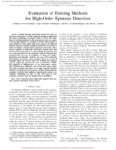Mostrar o rexistro simple do ítem
Evaluation of Existing Methods for High-Order Epistasis Detection
| dc.contributor.author | Ponte-Fernández, Christian | |
| dc.contributor.author | González-Domínguez, Jorge | |
| dc.contributor.author | Carvajal-Rodriguez, Antonio | |
| dc.contributor.author | Martín, María J. | |
| dc.date.accessioned | 2021-03-29T10:18:22Z | |
| dc.date.available | 2021-03-29T10:18:22Z | |
| dc.date.issued | 2020-10-15 | |
| dc.identifier.citation | C. Ponte-Fernandez, J. Gonzalez-Dominguez, A. Carvajal-Rodriguez and M. J. Martin, "Evaluation of Existing Methods for High-Order Epistasis Detection," in IEEE/ACM Transactions on Computational Biology and Bioinformatics, doi: 10.1109/TCBB.2020.3030312. | es_ES |
| dc.identifier.issn | 1557-9964 | |
| dc.identifier.uri | http://hdl.handle.net/2183/27617 | |
| dc.description.abstract | [Abstract] Finding epistatic interactions among loci when expressing a phenotype is a widely employed strategy to understand the genetic architecture of complex traits in GWAS. The abundance of methods dedicated to the same purpose, however, makes it increasingly difficult for scientists to decide which method is more suitable for their studies. This work compares the different epistasis detection methods published during the last decade in terms of runtime, detection power and type I error rate, with a special emphasis on high-order interactions. Results show that in terms of detection power, the only methods that perform well across all experiments are the exhaustive methods, although their computational cost may be prohibitive in large-scale studies. Regarding non-exhaustive methods, not one could consistently find epistasis interactions when marginal effects are absent. If marginal effects are present, there are methods that perform well for high-order interactions, such as BADTrees, FDHE-IW, SingleMI or SNPHarvester. As for false-positive control, only SNPHarvester, FDHE-IW and DCHE show good results. The study concludes that there is no single epistasis detection method to recommend in all scenarios. Authors should prioritize exhaustive methods when sufficient computational resources are available considering the data set size, and resort to non-exhaustive methods when the analysis time is prohibitive. | es_ES |
| dc.description.sponsorship | 10.13039/501100010801-Xunta de Galicia (Grant Number: ED431C2016-037, ED431C2017/04 and ED431G2019/01) 10.13039/501100003176-Ministerio de Educacion Cultura y Deporte (Grant Number: FPU16/01333) 10.13039/501100003329-Ministerio de Economia y Competitividad (Grant Number: CGL2016-75482-P, PID2019-104184RB-I00, AEI/FEDER/EU, 10.13039/50110 and TIN2016-75845-P) | es_ES |
| dc.description.sponsorship | Xunta de Galicia; ED431C2016-037 | es_ES |
| dc.description.sponsorship | Xunta de Galicia; ED431G2019/01 | es_ES |
| dc.description.sponsorship | Xunta de Galicia; ED431C 2017/04 | es_ES |
| dc.language.iso | eng | es_ES |
| dc.publisher | Institute of Electrical and Electronics Engineers | es_ES |
| dc.relation | info:eu-repo/grantAgreement/MECD/Plan Estatal de Investigación Científica y Técnica y de Innovación 2013-2016/FPU16%2F01333/ES/ | |
| dc.relation | info:eu-repo/grantAgreement/AEI/Plan Estatal de Investigación Científica y Técnica y de Innovación 2013-2016/CGL2016-75482-P/ES/CAUSAS Y CONSECUENCIAS DE LA EVOLUCION DE LA PREFERENCIA EN LA ELECCION DE PAREJA EN POBLACIONES NATURALES | |
| dc.relation | info:eu-repo/grantAgreement/AEI/Plan Estatal de Investigación Científica y Técnica y de Innovación 2017-2020/PID2019-104184RB-I00/ES/DESAFIOS ACTUALES EN HPC: ARQUITECTURAS, SOFTWARE Y APLICACIONES | |
| dc.relation | info:eu-repo/grantAgreement/MINECO/Plan Estatal de Investigación Científica y Técnica y de Innovación 2013-2016/TIN2016-75845-P/ES/NUEVOS DESAFIOS EN COMPUTACION DE ALTAS PRESTACIONES: DESDE ARQUITECTURAS HASTA APLICACIONES (II) | |
| dc.relation | info:eu-repo/grantAgreement/MINECO/Plan Estatal de Investigación Científica y Técnica y de Innovación 2013-2016/TIN2016-75845-P/ES/NUEVOS DESAFIOS EN COMPUTACION DE ALTAS PRESTACIONES: DESDE ARQUITECTURAS HASTA APLICACIONES (II) | |
| dc.relation | info:eu-repo/grantAgreement/AEI/Plan Estatal de Investigación Científica y Técnica y de Innovación 2017-2020/PID2019-104184RB-I00/ES/DESAFIOS ACTUALES EN HPC: ARQUITECTURAS, SOFTWARE Y APLICACIONES | |
| dc.relation | info:eu-repo/grantAgreement/AEI/Plan Estatal de Investigación Científica y Técnica y de Innovación 2013-2016/CGL2016-75482-P/ES/CAUSAS Y CONSECUENCIAS DE LA EVOLUCION DE LA PREFERENCIA EN LA ELECCION DE PAREJA EN POBLACIONES NATURALES | |
| dc.relation | info:eu-repo/grantAgreement/MECD/Plan Estatal de Investigación Científica y Técnica y de Innovación 2013-2016/FPU16%2F01333/ES/ | |
| dc.relation.uri | https://doi.org/10.1109/TCBB.2020.3030312 | es_ES |
| dc.rights | Atribución 4.0 Internacional (CC BY 4.0) | es_ES |
| dc.rights.uri | https://creativecommons.org/licenses/by/4.0/ | * |
| dc.subject | Genetics | es_ES |
| dc.subject | Filtering | es_ES |
| dc.subject | C++ languages | es_ES |
| dc.subject | Particle swarm optimization | es_ES |
| dc.subject | Matlab | es_ES |
| dc.subject | Clustering algorithms | es_ES |
| dc.subject | Detection power | es_ES |
| dc.subject | High-order epistasis | es_ES |
| dc.subject | False positives | es_ES |
| dc.subject | Genetic interaction | es_ES |
| dc.subject | Review | es_ES |
| dc.subject | Survey | es_ES |
| dc.title | Evaluation of Existing Methods for High-Order Epistasis Detection | es_ES |
| dc.type | info:eu-repo/semantics/article | es_ES |
| dc.rights.access | info:eu-repo/semantics/openAccess | es_ES |
| UDC.journalTitle | IEEE - ACM Transactions on Computational Biology and Bioinformatics | es_ES |
| dc.identifier.doi | 10.1109/TCBB.2020.3030312. |
Ficheiros no ítem
Este ítem aparece na(s) seguinte(s) colección(s)
-
GI-GAC - Artigos [189]






